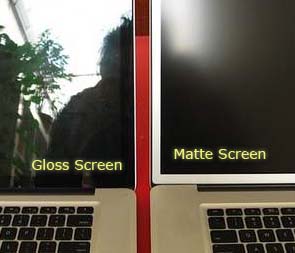Screen
There are three things that make up screens now:
- Gloss vs matt finish
- Size (physical)
- Resolution (how many pixels on screen)
 Gloss screens make colour look more vibrant and videos look crisper and clearer – but this is at the expense of severe reflection problems. Some are downright unusable in bright areas; even office lighting can make them very hard to see. You usually find glossy screens on “consumer” laptops (for use at home) as it’s easier to control lighting and they tend to be used more at night; corporate laptops are used in offices and outdoors more and tend to have matt screens which diffuse reflective light and make the image easier to see but as a trade-off the colour isn’t quite as vibrant or vivid. Have a look at both in a store or showroom – angle the screen to see if this bothers you and see if the reflections bother you. For some people it’s not an issue; just as when you look through a window and focus on what is outside so too can some manage to do this with a screen.
Gloss screens make colour look more vibrant and videos look crisper and clearer – but this is at the expense of severe reflection problems. Some are downright unusable in bright areas; even office lighting can make them very hard to see. You usually find glossy screens on “consumer” laptops (for use at home) as it’s easier to control lighting and they tend to be used more at night; corporate laptops are used in offices and outdoors more and tend to have matt screens which diffuse reflective light and make the image easier to see but as a trade-off the colour isn’t quite as vibrant or vivid. Have a look at both in a store or showroom – angle the screen to see if this bothers you and see if the reflections bother you. For some people it’s not an issue; just as when you look through a window and focus on what is outside so too can some manage to do this with a screen.
- Size – this is a big factor in determining the laptop’s overall size, indeed it’s the single biggest factor. Some are enormous – 17 and 18 inch screens adorn some larger gaming laptops now, they are big and easier to read from a distance or for use for long periods of time. The trade-off is a big hit on battery life (it takes a lot more power to run a larger screen), the size issue (a problem for carrying and limiting where you can set it up) and reduced privacy and discretion if you use it in a public place. Again this goes to personal preference and intended use – if it’s desk-bound, your eyesight is strained by small images or you want to use it at more of a distance then a larger screen may be better.
- Resolution – this is how many dots are on a screen at any given time. This is usually related to size as well; really small screens with a lot of pixels makes them very tiny and hard to see, this is fine for making an image clearer but may not benefit you that much in the long run and may even make text too small to read properly. Resolution that is too low makes everything larger but also makes the picture look more blocky and you can’t fit as many things on the screen at once even if it’s a larger screen; remember the icons, text, etc. are all related to the number of dots rather than the physical size.
Some screens now have so-called “retina” or “retina-like” displays – extremely high resolution screens that are intended to have pixels so small you can’t easily see them individually. This works with newer versions of windows, MacOS, Linux, etc. which draw text and images in a different way – so an icon that is, say, 1cm-square in size will still be the same size but will have more detail and clarity on these newer screens. They are harder to “drive” (for the computer to generate the picture) and some games may not work on them properly; they are becoming more common now however as they offer more flexibility and photographs can look extremely detailed on their screens as well as making text sharper and more vibrant.